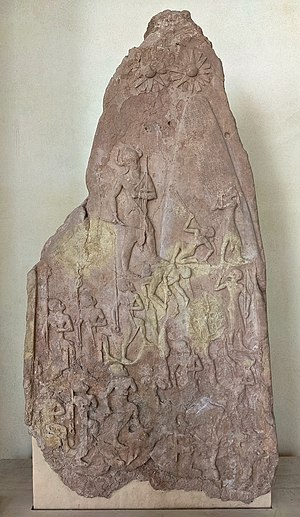
Back Oorwinningstele van Naram-Sin Afrikaans مسلة النصر لنارام سين Arabic Estela de Naram-Sin Catalan Narām-Sîn-Stele German Estela de Naram-Sin Spanish Naram-Simen estela Basque کتیبه نارامسین Persian Stèle de victoire du roi Naram-Sin French האסטלה של נרם-סין HE Naram-Sinova stela Croatian
| Victory Stele of Naram-Sin | |
|---|---|
 | |
| Material | Limestone |
| Height | 200 centimetres (79 in) |
| Width | 150 centimetres (59 in) |
| Created | c. 2250 BC |
| Period/culture | Akkadian Empire |
| Discovered | Jacques de Morgan, 1898 |
| Place | Sippar, later moved to Susa |
| Present location | Musée du Louvre, Paris |
| Identification | Sb 4 |
Original location of the stele, in Sippar, Mesopotamia, modern Iraq, before being moved to Susa, Iran, by Shutruk-Nakhunte in the 12th century BC. | |
The Victory Stele of Naram-Sin is a stele that dates to approximately 2254–2218 BC, in the time of the Akkadian Empire, and is now at the Louvre in Paris. The relief measures 200 cm. in height (6' 7")[1] and was carved in pinkish sandstone,[2] with cuneiform writings in Akkadian and Elamite. It depicts the King Naram-Sin of Akkad leading the Akkadian army to victory over the Lullubi, a mountain people from the Zagros Mountains.
The stele shows a narrative scene of the king crossing the steep slopes into enemy territory; on the left are the ordered imperial forces keeping in rank while marching over the disordered defenders that lie broken and defeated. Naram-Sin is shown as by far the most important figure, towering over his enemy and troops and all eyes gaze up toward him. The weak and chaotic opposing forces are shown being thrown from atop the mountainside, impaled by spears, fleeing and begging Naram-Sin for mercy as well as being trampled underfoot by Naram-Sin himself. This is supposed to convey their uncivilized and barbaric nature making the conquest justified.[1] Though currently about two meters in height estimates of its original height range up to three meters.[2]
- ^ a b "Victory Stele of Naram-Sin". American Historical Association. 2 October 2008.
- ^ a b Winter, Irene J.. "How Tall Was Naram-Sîn’s Victory Stele? Speculation on the Broken Bottom". Leaving No Stones Unturned: Essays on the Ancient Near East and Egypt in Honor of Donald P. Hansen, edited by Erica Ehrenberg, University Park, USA: Penn State University Press, 2021, pp. 301-312
© MMXXIII Rich X Search. We shall prevail. All rights reserved. Rich X Search
